Apthorp House, which sits quietly in a green quadrangle at the center of Adams House, has had a fascinating and sometimes tumultuous history. In its 250 years, the house has been the center of a religious controversy, the headquarters of an American general and the involuntary residence of a British general during the American Revolution, a rowdy undergraduate dormitory, and the residence of the masters of Adams House.
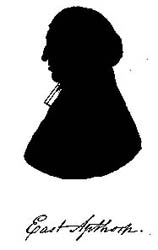
East Apthorp Builds a Splendid House
East Apthorp, the builder of Apthorp House, was born in 1733 into a prosperous Boston family. He attended Boston Latin School then studied abroad, receiving his B.A. in 1755 and his M.A. in 1758 from Jesus College at Cambridge University. He returned to Boston when his father died in November 1758.
Apthorp remained in Massachusetts and became the rector of Christ Church in Cambridge. The Anglicans of Cambridge, tired of making the trip to services at King’s Chapel in Boston, petitioned the Church of England’s Society for the Propagation of the Gospel in Foreign Parts to dispatch a mission to Cambridge to set up their own church. One Cambridge Anglican wrote that a minister like East Apthorp would “give a great check to the fashionable licentiousness…which even such seminaries of learning and Education [i.e., Harvard] are not always free from.” East Apthorp accepted the invitation of the Society and the Cambridge Anglicans to be rector of the new church.
Construction of Apthorp House began in 1760, but was not completed until mid-1761. East Apthorp married Elizabeth Hutchinson on August 27, 1761, and moved into his new house shortly thereafter. He began his duties at Christ Church when it opened on October 15, 1761. Despite the Reverend Apthorp’s efforts, the congregation remained small, although he acknowledged that “those we have are serious and respectable characters.”
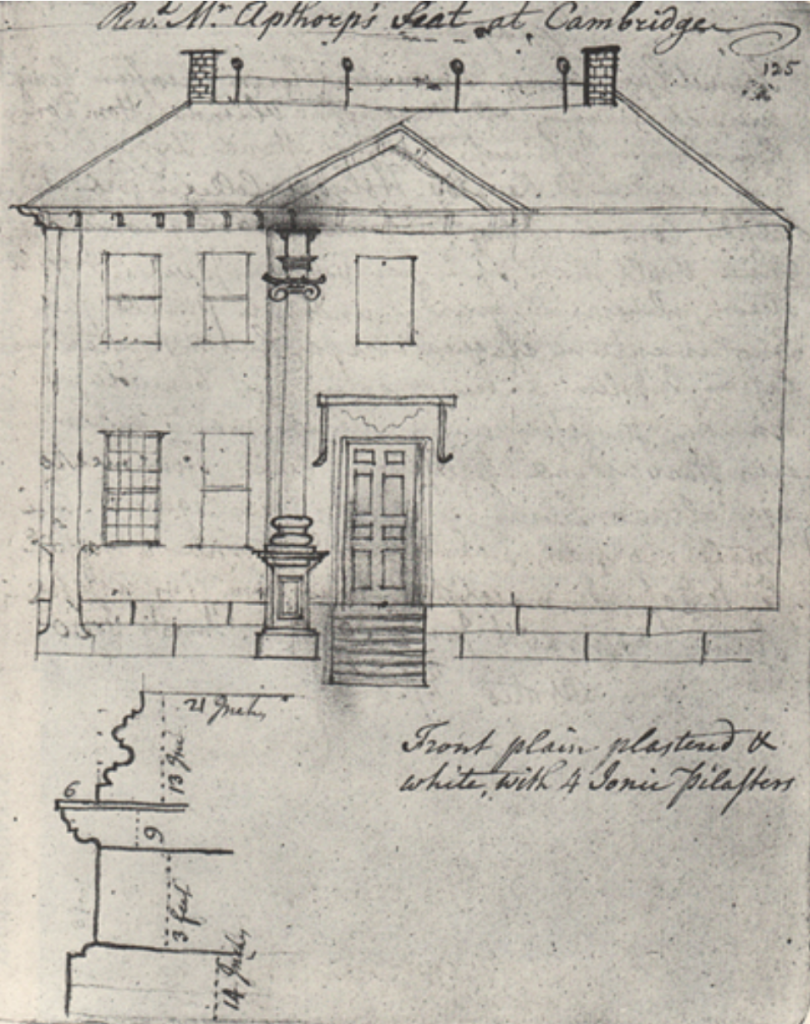
Ezra Stiles sketched Apthorp House in 1761, immediately upon its completion.
Apthorp House is a prime example of a grand eighteenth-century mansion. It originally stood in the midst of extensive gardens and commanded a view of the Charles River. It was built with elements of the Palladian style, which was then fashionable among the rich and cultured of England and the colonies. The house’s exterior is distinguished by its Palladian proportions, massive Ionic pilasters, and prominent projecting central pavilion.
Peter Harrison, one of America’s first professionally trained architects, was probably the designer of Apthorp House. An anti-Tory mob destroyed Harrison’s papers in 1775, so no records of his plans for Apthorp House survive, but Wendell Garrett, author of Apthorp House, 1760–1960, sees evidence that Harrison was the architect. Harrison was a business associate of the Apthorp family. He also designed Christ Church, so it would not be surprising for him to be the architect of its minister’s house. Apthorp House shares many stylistic features with Harrison’s other buildings.
A Religious Controversy: The Reverend Apthorp Departs
The Reverend Apthorp had little opportunity to enjoy his new house and position. In 1762, a rumor spread that the Church of England planned to appoint a bishop in the colonies and that Apthorp was a likely candidate. The Reverend Jonathan Mayhew of Boston’s Congregational West Church was especially vigorous in his opposition to the rumored appointment of an Anglican bishop, fearing that a bishop would strengthen the Anglican Church and encourage more converts from other churches. Mayhew claimed that there was “a formal design to carry on a spiritual siege of our churches.”
The controversy over the potential appointment of an Anglican bishop may now seem arcane and insignificant. In the New England of the1760s, however, it reflected the deep social and religious divisions of colonial America. The Congregationalists were heirs to the Puritan tradition. They remained suspicious of Anglican motives and actions. The dispute was hardly trivial; many historians regard it as one of the leading causes of the American Revolution.
Apthorp House itself played a central role in the controversy. Mayhew regarded the house as a “superb edifice” that might serve as a bishop’s palace. Whether or not the Reverend Apthorp hoped to become a bishop, the charge that his house was built to be a bishop’s palace seems implausible. Apthorp probably built a grand house because he could afford to and because he was accustomed to living in style. His father had been a rich merchant whose mansion on King Street (now State Street) was one of the finest in Boston. Although East Apthorp was not the family’s eldest son, he inherited a substantial sum of money when his father died and was able to build his house with minimal help from the congregation of Christ Church.
As the controversy over his purported ambitions raged, East Apthorp decided to abandon any hopes of becoming an American bishop—and his splendid house in Cambridge. In January 1764, he wrote to the Society for the Propagation of the Gospel to request that he be allowed to return to England to attend to “private matters.” This request may have reflected his desire to escape the controversy and to pursue a more tranquil life or it may have been prompted by the Church of England’s desire to conciliate its opponents. In any case, the Reverend Apthorp left his congregation and house in Cambridge and on September 17, 1764, sailed for England, where he subsequently served as vicar of Croydon, rector of St. Mary-le-Bow in London, prebendary of St. Paul’s Cathedral, and prebend of Finsbury. He died in 1816 and is buried in the chapel of Jesus College at Cambridge University.
After East Apthorp’s departure, his brothers sold Apthorp House to John Borland. Like Apthorp’s family, Borland’s family had prospered in trade. Borland owned the house in Braintree that was to become the “old house” of John and Abigail Adams and their descendants, but he preferred a larger residence in Cambridge that was closer to his wife’s cousins, the Vassalls (who built what would become the Longfellow House in Brattle Street.) Apparently, Apthorp House was not large enough for his twelve children, servants, and two slaves, so Borland added a third storey.
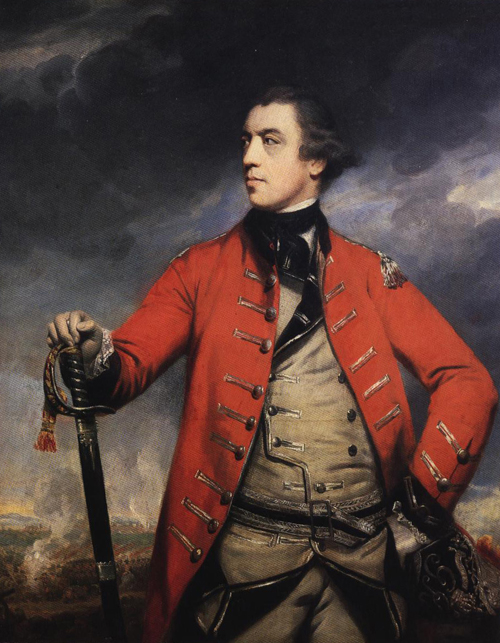
General Johnny Burgoyne by Sir Joshua Reynolds
Apthorp House in the American Revolution
Some of the most significant events in the history of Apthorp House occurred during the American Revolution. The political upheaval forced John Borland to flee to his Boston house in early 1775, abandoning Apthorp and his possessions in the face of threats from rebellious anti-Tory mobs.
After Borland’s departure, General Israel Putnam, who had arrived from Connecticut to help lead the colonial troops, moved into Apthorp House, which had been appropriated by the revolutionary forces. General Putnam fought bravely in the Battle of Chelsea Creek on May 27, 1775, and then returned to Apthorp House in high spirits and told his fellow officers that “we shall have no peace worth anything, till we gain it by the sword.” John Borland, Apthorp’s erstwhile owner, watched the battle from the roof of his Boston house. He fell as he descended, injuring himself so severely that he died shortly thereafter.
Apthorp House remained General Putnam’s residence and headquarters during the late spring and early summer of 1775. Putnam and his fellow American officers planned the Battle of Bunker Hill there in June. General Artemas Ward, the cautious commander of the American forces surrounding Boston, hesitated to occupy the hills of Charlestown, but Putnam eagerly advocated fortifying the high ground and played a prominent role in the battle.
Later in the American Revolution, the British general, John “Gentleman Johnny” Burgoyne, was confined in Apthorp House. Burgoyne and his troops had surrendered after their defeat at the Battle of Saratoga in October 1777. Under the terms of their surrender, they would not be held as prisoners of war but would be taken to Cambridge, where they would stay until British ships arrived to transport them home. When Burgoyne arrived in Cambridge in November 1777, an American officer leased Apthorp House to him until April for £150, which Burgoyne thought exorbitant: “a larger sum, for an unfurnished house out of repair, than would have been required for a palace in the dearest metropolis of the world.” Burgoyne sailed for England on April 6, 1778. His ghost is said to haunt Apthorp House.
Following Burgoyne’s departure, his second-in-command, General Philips, took charge of the British troops in Cambridge and moved into Apthorp House. He complained frequently about the treatment of his soldiers. After several testy exchanges with American generals and incidents involving Cambridge residents, the American military placed Philips under house arrest in Apthorp House.
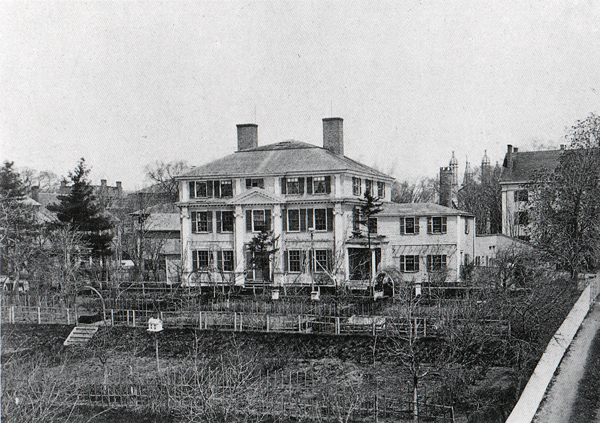
This view of Apthorp House taken sometime in the late 1800’s before the construction of Randolph Hall gives a good idea of House’s size and the extent of the gardens. The neo-Gothic spires of Gore Hall, Harvard’s library can be glimpsed in the background
The Nineteenth Century
John Borland’s untimely death enabled his family to reclaim Apthorp House after the Revolution, because he died before the confiscation of the property of loyalists who had fled. Borland’s heirs sold the house to Jonathan Simpson, who owned it from 1784–1802. Simpson found himself in financial difficulty. He divided the property, making possible the construction of what are now Linden and Plympton Streets, and eventually sold the house to Timothy Lindall Jennison and Thomas Warland.
Jennison leased his half of Apthorp House to Warland, but initially continued to live there and temporarily revived the house’s connection to the Apthorp family. In 1803 Susan Apthorp Bulfinch, sister of East Apthorp and mother of Charles Bulfinch, wrote to East Apthorp’s daughter to report that her son, Joseph Coolidge, had taken a room with the Jennison family.
When Warland died in 1837, Apthorp House passed to his daughters, Elizabeth and Mary. They and their families lived in Apthorp for the rest of the nineteenth century. Elizabeth Warland, who was widowed twice, took in Unitarian clergymen and Harvard affiliates as lodgers. One was John Langdon Sibley, author of Sibley’s Harvard Graduates. Mary Warland married Dr. Sylvanus Plympton, a Cambridge selectman and state representative. After the Plymptons’ son, Henry, died in the Civil War in 1863 and Dr. Plympton died in 1865, the Cambridge City Council gave the family name to adjacent Plympton Street, which had been known as Chestnut Street.
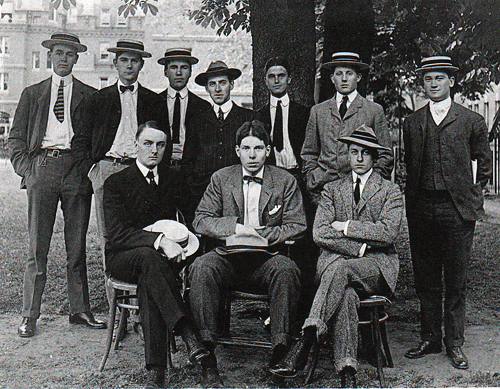
The residents of Apthorp in 1902, FDR’s sophomore year.
Apthorp as an Undergraduate Dormitory
In 1901, Apthorp House was bought by Harvard Professor Archibald Cary Coolidge and his brothers, who were descendants of East Apthorp’s sister, Susan Apthorp Bulfinch. The Coolidge brothers had previously bought the front yard of Apthorp House and erected Randolph Hall there in 1897. They hoped to make a profit by operating a private “Gold Coast” dormitory that would offer luxurious accommodation to Harvard undergraduates. Apthorp thus became part of a residential complex that included Randolph Hall and an athletic building that was subsequently built behind Apthorp House. Apthorp was a dormitory between 1901 and 1930.
Undergraduate life in Apthorp was raucous and spirited. The house became renowned for parties and was a center of Gold Coast social life. Little changed after Harvard acquired Apthorp and the Randolph complex in 1916. Students held indoor shooting practice, smashed beer bottles against the wall of the athletic building, and were steady customers of a local bootlegger during prohibition. One kept a pet monkey. In his 1933 novel, Not to Eat, Not for Love, George Weller writes of Apthorp life in the 1920s, describing football games in the halls, water fights, and snowballs flying through windows. As a lasting legacy of the era of “Apthorp College,” students scrawled graffiti on the walls of what were once student bedrooms on the top floor of Apthorp.
The Master’s Residence: Apthorp House and Adams House
Apthorp House’s days as a dormitory ended in 1930, after President Abbott Lawrence Lowell decided to make Apthorp the residence of the master of Adams House. During 1930–31 Apthorp was renovated and restored. The plumbing, partitions, and stairs added when the house had been a two-family residence and dormitory were removed. About forty coats of paint were stripped from the walls. The original panels, mantels, cornices, and tiles were repaired or replaced. Thus restored and revived, Apthorp became the residence of the successive masters of Adams House: James Phinney Baxter, David Mason Little, Reuben Brower, William Liller, Robert Kiely, and currently, Judith and Sean Palfrey.
This brief history relies heavily on Wendell Garrett, Apthorp House, 1760–1960 (Cambridge, Mass.: Adams House, 1960), which remains the most detailed and comprehensive work on Apthorp House.
